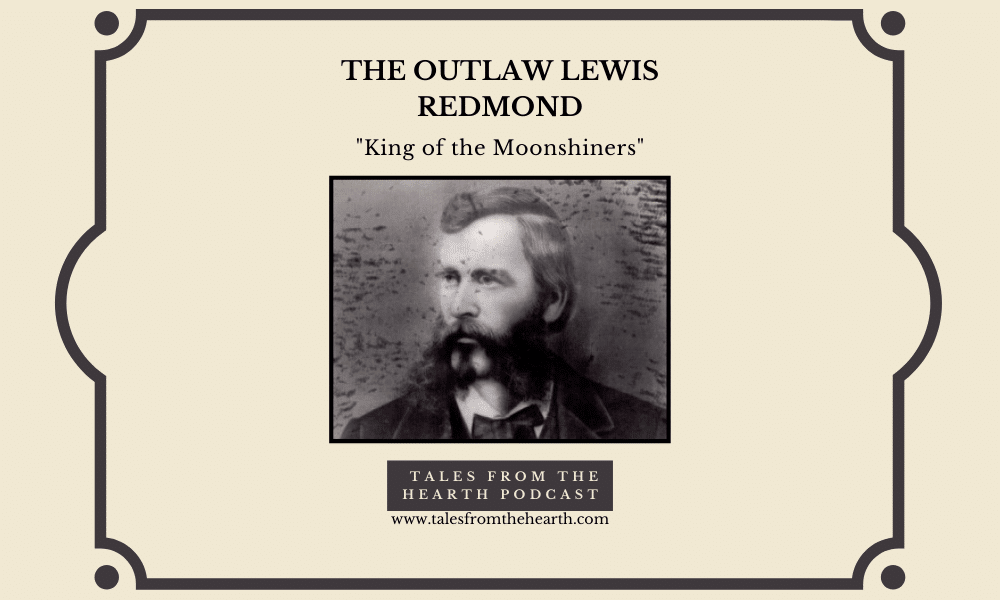The Outlaw Moonshiner Lewis Redmond
Have you ever heard of the tales of an Appalachian moonshiner and outlaw who was shot many times and still lived to be put on trial? How about a moonshiner who was pardoned by a U.S. president, then hired to run a federal distillery? Join us for today’s episode on the legend of the outlaw Lewis Redmond.
Let’s get cracklin’, shall we?
**********
Of all the post-Civil War Reconstruction outlaws, the Carolinas claim Lewis Redmond as a folk hero.
The majority of what was known about Lewis Redmond is now lost, but his legend and tales have grown over time. There are many versions of the stories about the outlaw, depending upon which side of the law the person who told them was on.
Considered a Robin Hood of Appalachia, Lewis Redmond’s moonshine operations stretched from Northeast Georgia across the Carolinas and into Tennessee. According to newspaper interviews with Redmond himself, he provided for poor and hungry families, widows, and children devastated by the Civil War in the South. He paid property taxes for those who couldn’t so his family, friends, and others could keep their homes.
For background, during the Civil War the federal government created an internal revenue and tax collection system to fund the war effort. This later led to the post-Civil War Reconstruction taxation of income, property, and alcohol, which many farmers in the South just couldn’t pay.
To avoid taxes on alcohol and to obtain cash, farmers turned to making and distributing moonshine, often referred to as “Mountain Dew.”
Some federal tax marshals, called “revenuers,” recruited by the federal government to collect taxes had questionable backgrounds and morals. Corruption was rampant, and marshals were incentivized and paid even more money the more taxes they collected. You can see where this is going—nowhere good.
Confrontations between moonshiners and revenuers in the South almost always involved violence and gunfire. Things were so bad that authorities dispatched United States armed forces to protect revenue agents.
You’ll hear about a lot of shootouts and showdowns in Lewis Redmond’s tale. What’s interesting is that at the height of his legend, historians say that Lewis Redmond only killed one man, and maybe had fifteen “gang” members.
Sources for today’s story are: Many! As always, refer to the episode show notes at www.talesfromthehearth.com for links to all of the resources for today’s episode.
A primary resource for today’s story is King of the Moonshiners:Lewis R. Redmond in Fact and Fiction edited by Brian E. Stewart.
Another resource is the documentary film, The Outlaw Lewis Redmond.
You can view many photos and links to information about Lewis Redmond, and other tidbits from today on our Pinterest board located at https://www.pinterest.com/TalesfromtheHearth/lewis-redmond/.
The one takeaway I hope you get from this story is: Running from the law is a young man’s game.
Now, I hope you enjoy the story of the Outlaw Lewis Redmond.
**********
Lewis Redmond was one of the early kings of moonshiners, and he started early.
Lewis Richard Redmond was born on April 15, 1854, in either Swain County, North Carolina, or in Rabun County, Georgia—too young to serve in the Civil War, but old enough to support his family by making moonshine. Stories tell that Lewis received the nickname “Major” as a boy because he spent so much time in local Confederate soldier camps. The name would stick for the rest of his life.
After the Civil War in the mid-187os, Lewis was the only surviving son of three boys and worked with his father to make and transport moonshine to provide for the family, which included seven sisters.
Lewis’s activities were soon found out, and warrants issued for his arrest. During a raid on the Redmond home, Lewis escaped, but authorities arrested and imprisoned his father. Lewis believed that the shock of the raid killed his sick mother a few days later, and the harsh prison conditions killed his father.
Twenty-year-old Lewis was left to care for his sisters and provide for them in the best way he knew how—moonshine.
There are many versions of the story that led to Redmond’s status as a murderer and outlaw. One version is that on March 1, 1876, in Transylvania County, North Carolina, Federal Deputy Marshal Alfred Duckworth met a 21-year-old Redmond with a fake warrant to get Redmond to reveal his operations, and Redmond shot him in the throat in self-defense.
Another version is that, indeed, the warrant was real, and Marshal Duckworth stopped Redmond and a colleague in their wagon at gunpoint. “All right, put up your pistol, Alf, I will go along with you,” replied Redmond. When Duckworth lowered his pistol, Redmond grabbed a gun from his colleague and shot Duckworth in the throat—leading to his painful death.
After the murder, Lewis Redmond escaped North Carolina by heading down to Pickens County, South Carolina—referred to as the “Dark Corner” of the state—for its associations with moonshine. He had family and friends in the area, including his best friend and sidekick, Amos Ladd, whose sister, Adeline, Redmond would court and marry in 1878.
In January 1877, revenue marshals had heard of Redmond’s new hideout and operations center near Liberty, South Carolina, and attempted to apprehend the 22-year-old Redmond while posing as customers. Revenuers captured, tied, and bound Redmond and another colleague (presumably Amos Ladd). Somehow Redmond was able to throw off his bindings to make an escape into the nearby woods.
The marshals took off with the other prisoner and Redmond’s wagon and some of his horses and other belongings, but didn’t make it far at all until they ran into an ambush. Redmond’s men shot and wounded a couple of marshals in the attack, including Deputy Marshal Barton. Nine days later, Redmond and nine others (all heavily armed) descended upon Barton’s home and demanded he return Redmond’s horses and personal property.
When Barton told Redmond that his horses were in Greenville, South Carolina, Redmond made Barton’s wife go with him to a nearby bank to pay $105 to Redmond for the loss of the horses. To add insult to injury, Redmond not only received his $105 from Barton, but also took the man’s very best horse. This was on top of the fact that Barton was still recovering from gunshot wounds from Redmond’s first attack.
As you can imagine, this did not go over well with authorities, who brought in additional veteran agents and authorized the use of the military to bring in Redmond and his associates. Throughout 1877, skirmishes and bloodshed continued—and escalated—between Redmond and the law, becoming national news when The New York Times started publishing about them. The New York Times painted a picture of Redmond as an outlaw, while local and regional news hailed Redmond as a hero.
In March 1878, Redmond and fifteen men orchestrated a jailbreak for three of his men out of the Pickens County Jail. Over the next few days the gang visited, ransacked, and stole from various revenuers’ homes, warning them to stop their attempts to reign in Redmond and his activities. This only resulted in additional crackdowns from the authorities, including offering cash rewards, additional manpower, and authorizing the arrest of Redmond by any means possible, and “at any cost.” Redmond was only 23 years old at this time.
In June 1878, federal marshals devised a plan to track Redmond through his sweetheart.
They knew that Lewis Redmond was dating his best friend Amos Ladd’s sister, Adeline, and was often a guest at the Ladd household. Therefore, they planned an ambush at the Ladd home (I’m really surprised it took them that long to try this tactic). There are a few versions of the story, but one is that four marshals camped nearby and waited to advance until they saw that Redmond and Ladd were inside the home. One marshal came to the front of the house and encountered Amos Ladd, who pulled a gun—which misfired. Amos ran off to the back of the house, where another marshal shot him three times, resulting in his death.
Another version of the story told by local newspapers was that of outrage and cowardly murder. Amos Ladd was merely half standing/half resting against the front door of his home when a marshal approached and shot and killed him without warning.
All four marshals fled after the death of Redmond’s 21-year-old right-hand man, fearing for their lives. Outrage over Amos’s death ensued. The marshals turned themselves in to local law enforcement, where authorities charged all four with first degree murder. The trial process dragged on until a jury acquitted all four marshals of Amos Ladd’s murder in 1882 (after Redmond’s trial had ended).
Shortly after Amos’s death in June 1878, The Charleston News and Courier published a series of interviews with Lewis Redmond. Redmond provided explanations of his actions, saying that he had shot and killed Marshal Duckworth in self-defense, paid the taxes for the poor so they could keep their homes, took Marshal Barton’s horse because Marshal had treated him terribly first, and insisting that he wasn’t actually in attendance during that jailbreak. “I only want peace, so I can go back to my farm and work for myself and my sisters, without being shot at every day like a dog. They have shot at me twenty-six times already, and I think that ought to be enough,” claimed Redmond in the interview.
The articles (coupled with the death of Amos Ladd) did as they were intended, garnering more sympathy for Redmond and Southern moonshiners and galvanizing support for their cause. Federal Internal Revenue Service leaders decided to change directions and declared that they would no longer enforce revenue laws with weapons. Federal authorities developed a plan to grant reprieves to moonshiners who resolved to legalize their operations (or stop illegal distilling). The results were astounding. It seems that moonshiners had grown tired of the lifestyle of strife, and in 1878 in South Carolina alone, 167 moonshiners took the government up on this offer, with the number of legal stills increasing from 7 to 109 in 1879.
This reprieve was not extended to Redmond, however, and he did not surrender to the authorities. In early 1879, Redmond chose to flee to North Carolina to the area of current-day Fontana Lake and Bryson City.
At this time, 24-year-old Redmond was so nationally famous that he was the subject of a fictional dime novel published in 1879, Entwined Lives of Miss Gabriel Austin, Daughter of the Late Rev. Ellis C. Austin, and of Redmond, the Outlaw, Leader of the North Carolina “Moonshiners,” by Bishop Edward B. Crittenden. The novel portrayed Redmond as a Princeton-educated hero who rescues a damsel in distress, who only turns to illegal moonshining after the death of his father at the hands of federal revenuers. Redmond and others denounced the novel as entirely false.
For the next two years Redmond laid low but did not entirely cease his operations. In early 1881, Redmond nearly escaped capture near his home in North Carolina, where he shot two rounds at the marshals before running into the woods. On April 7, 1881, revenuers finally camped out in the woods near Redmond’s home and confronted the outlaw. “Halt!” they yelled. Redmond flashed his shotgun and the marshals shot him six times. He managed to run half a mile away until he collapsed due to injuries. He was only 26 years old.
According to a documentary film, The Outlaw Lewis Redmond, his death was erroneously announced on the very front page of The New York Times (while Billy the Kid’s death only made it to page 8 a few months later).
Federal marshals took Redmond into custody, where he recovered from his bullet wounds. According to newspapers, no less than 500 well-wishers visited the outlaw and showered the folk hero with flowers, food, tobacco, and booze. Federal authorities charged Redmond with violations of revenue laws and conspiracy—but strangely, not for the murder of Federal Marshal Alfred Duckworth. His trial began and ended in August 1881, where he was found guilty and sentenced to ten years, to be served in a federal facility in New York State.
Northern newspapers called the sentencing justice, while some locals and Southerners called the sentencing an outrage—though not as many as you would think. Support for moonshiners was dwindling throughout Appalachia as industrialization in the area led to increased fortunes, and tolerance for continued violence wore thin.
Robert Cobb, the man who arrested Redmond, published the novel The True Life of Maj. Lewis Richard Redmond, the Notorious Outlaw and Famous Moonshiner of Western North Carolina later in 1881.
Lewis Redmond’s popularity continued throughout the years, however, and on May 16, 1884, President Chester A. Arthur granted the moonshiner a full pardon. He ended up serving less than three years of his sentence and had just turned 30 years old.
Redmond returned to South Carolina and lived a peaceful life with his wife and nine children. He never spoke to reporters or broke the law ever again.
In 1886 (just two years after his release), Redmond was hired to legally run a government distillery near Walhalla, South Carolina. The former moonshiner really did know how to make some high-quality booze, and his liquor regularly sold out until he retired due to ill health around 1905.
Lewis Redmond passed away on April 5, 1906, in Walhalla, South Carolina.
So what are your thoughts on Lewis Redmond? I’m so surprised a movie hasn’t been made yet—it would be a high action one, don’t you think?
That’s it for today! I hope you enjoyed today’s story of the Outlaw Lewis Redmond.


